Derby's Heritage Part 14 - Between The Museums
w/e 27 February 2011
All this week's pictures were taken
with a Kodak DX6490
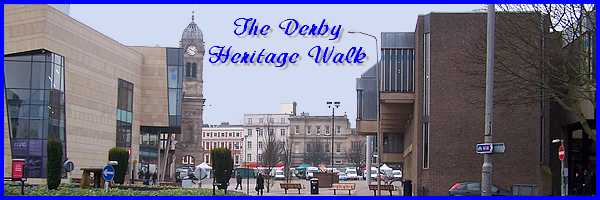
In our walk around Derby we had reached Pickford's
House Museum on Friar Gate at the end of the previous part and
now continuing along Friar Gate takes us to the Derby Museum
and Art Gallery. Ongoing road works and repair and restoration
to some of the buildings coupled with a dull February day do
little to enhance the images but this is the hand we have been
dealt and to appreciate the architecture fully it is probably
necessary to look beyond the barriers and scaffolding.

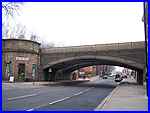 The first
architectural feature of note on leaving Pickford's House is
the Friar Gate Railway Bridge. The bridge is more commonly seen
from the opposite side (left) particularly by motorists as it
crosses a one-way section of the road. A Grade II listed structure
the ornately embellished cast iron double bridge was made in
1876 by Derby's own iron founder Andrew Handyside for the Great
Northern Railway's extension. The extension did not go down well
with nearby residents who objected strongly to the building of
the line and the embellishments which included the Borough's
badge in the spandrels were an attempt to pacify them. Following
the infamous Dr Beeching review the line closed in May 1968.
Friar Gate Station was to the right of the bridge in the image
above and I can never see the bridge without remembering a pre-Christmas
steam train ride from Ilkeston in 1959 with some school friends.
How times have changed. A ten mile excursion would be regarded
as nothing special by today's youngsters of a similar age but
to us it was a great adventure. Since those halcyon days of youth
the bridge has been allowed to deteriorate and Andy Savage has
a special feature and petition on his derbyphotos website with a lot more information
about the area as well as a friargatebridge blog dedicated to the work
of Andrew Handyside. The first
architectural feature of note on leaving Pickford's House is
the Friar Gate Railway Bridge. The bridge is more commonly seen
from the opposite side (left) particularly by motorists as it
crosses a one-way section of the road. A Grade II listed structure
the ornately embellished cast iron double bridge was made in
1876 by Derby's own iron founder Andrew Handyside for the Great
Northern Railway's extension. The extension did not go down well
with nearby residents who objected strongly to the building of
the line and the embellishments which included the Borough's
badge in the spandrels were an attempt to pacify them. Following
the infamous Dr Beeching review the line closed in May 1968.
Friar Gate Station was to the right of the bridge in the image
above and I can never see the bridge without remembering a pre-Christmas
steam train ride from Ilkeston in 1959 with some school friends.
How times have changed. A ten mile excursion would be regarded
as nothing special by today's youngsters of a similar age but
to us it was a great adventure. Since those halcyon days of youth
the bridge has been allowed to deteriorate and Andy Savage has
a special feature and petition on his derbyphotos website with a lot more information
about the area as well as a friargatebridge blog dedicated to the work
of Andrew Handyside.
|

 Progressing
along Friar Gate and crossing the Ford Street/Stafford Street
(left) junction we come to The Friary. This is a Grade II* listed
building that was built in 1731 for banker Samuel Crompton, son
of the Abraham Crompton who had founded Derby's first bank in
1685. It is on the site of a Dominican Friary that had been founded
in 1238. The house was extended and altered about 1770, owned
by the Mozley family from 1817 until 1874 and was then modified
and enlarged further for lace maker Henry Boden in 1875. It remained
in the Boden family until 1922 and when his widow sold the house,
it became a hotel in 1922 and a pub in 1996. Progressing
along Friar Gate and crossing the Ford Street/Stafford Street
(left) junction we come to The Friary. This is a Grade II* listed
building that was built in 1731 for banker Samuel Crompton, son
of the Abraham Crompton who had founded Derby's first bank in
1685. It is on the site of a Dominican Friary that had been founded
in 1238. The house was extended and altered about 1770, owned
by the Mozley family from 1817 until 1874 and was then modified
and enlarged further for lace maker Henry Boden in 1875. It remained
in the Boden family until 1922 and when his widow sold the house,
it became a hotel in 1922 and a pub in 1996.
|
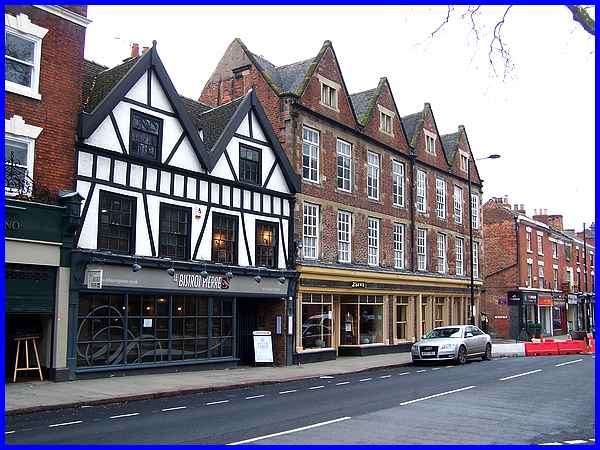
There are many old buildings along both sides of this section
of Friar Gate and many of them now operate as pubs, wine bars,
nightclubs or restaurants. Across from The Friary are two examples
of where old buildings have been converted. The black and white
building dates from the 1600s but now houses "Le Bistrot
Pierre" whilst its four gabled neighbour that was built
in 1643 and belonged to Civil War hero Sir John Gell is now an
Italian restaurant and carries the name "Zizzi".
|

Among the other buildings is this one that does not go back quite
as far as those in the previous image although it is well over
one hundred years old. The brickwork as well as telling us that
it was once an office building for the Derby Gas Light &
Coke Company also includes the date 1889. It has been occupied
by various other concerns during its lifetime and although part
of it is now empty, the left hand side has become a casino. To
the right of the image is St Werburgh's Church.
|
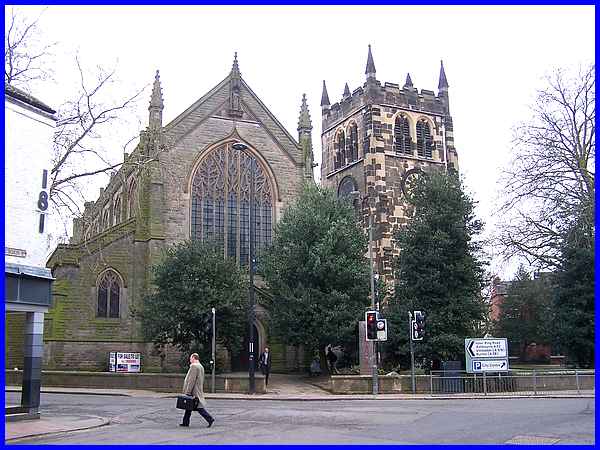
St Werburgh's Church (Grade B listed) marks
the end of Friar Gate and the church is seen here from the mouth
of Curzon Street. Although nothing remains of the original church,
it was founded about 700 AD and was dedicated to St Werbergha,
the granddaughter of the Mercian King Penda. Much of the present
building despite its fifteenth century gothic style was rebuilt
between 1889 and 1894 to a design by the prolific Victorian architect
Sir Arthur Bloomfield. The tower is older than that though and
cannonball shots thought to have been fired by Sir John Gell's
Parliamentary Army as they entered the town on October 31st 1642,
can still be seen on the northwest side. Another notable event
in the church's history is that it is where the marriage of Dr.
Samuel Johnson to Elizabeth (Tetty) Porter took place on July
9th 1735. Sadly St Werburgh's was declared redundant in 1990
and for a while part of the building was converted into a restaurant
and shopping arcade but it currently stands empty.
|
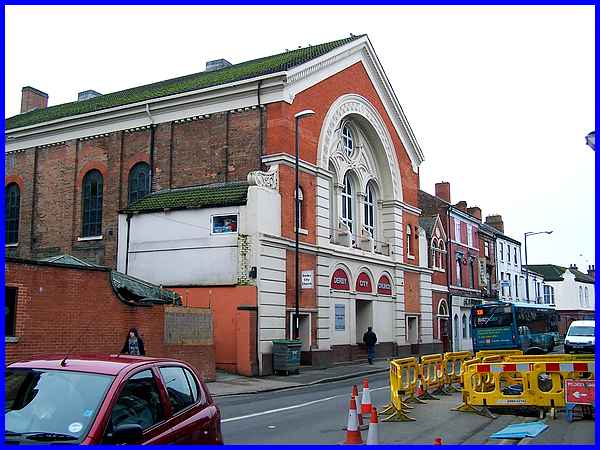
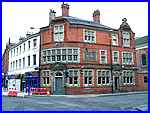 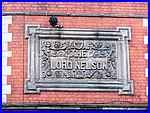 Diagonally across the road junction from
St Werburgh's Church stands another old building on the corner
of Curzon Street (left). This is currently the Deez nightclub
but the ornate brick and stonework bearing the name "The
Lord Nelson" (right) suggests that the building dates from
the same period as other buildings nearby. Just a few steps along
Curzon Street is the Derby City Church (above) which, like the
Derby Gas Light and Coke building in Friar Gate, has brickwork
that includes the date 1889 on the façade. The church
is part of the Elim Pentecostal Church that was founded in 1915
in Monaghan Ireland by a Welshman, George Jeffreys. Diagonally across the road junction from
St Werburgh's Church stands another old building on the corner
of Curzon Street (left). This is currently the Deez nightclub
but the ornate brick and stonework bearing the name "The
Lord Nelson" (right) suggests that the building dates from
the same period as other buildings nearby. Just a few steps along
Curzon Street is the Derby City Church (above) which, like the
Derby Gas Light and Coke building in Friar Gate, has brickwork
that includes the date 1889 on the façade. The church
is part of the Elim Pentecostal Church that was founded in 1915
in Monaghan Ireland by a Welshman, George Jeffreys.
|
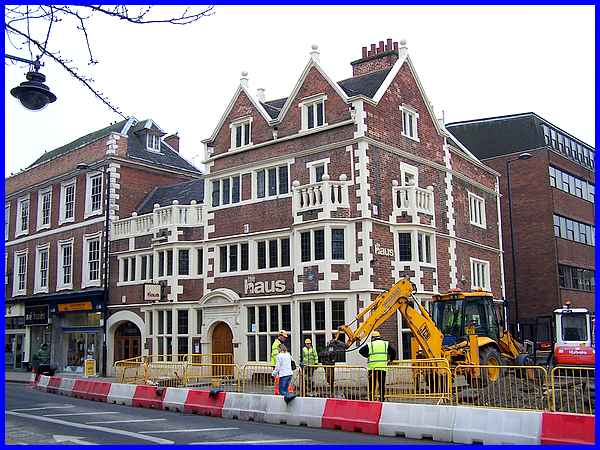
The continuation of Friar Gate is now called The Wardwick and
on the corner of Becket Street is The Haus restaurant. It is
also known as the Jacobean House and is Grade II* listed. Built
in 1611 it was lived in by John Gisborne whose fourth son became
Physician in Ordinary to King George III and President of the
Royal College of Physicians. Tactfully modified in 1855 by architect
John Price to allow access to Becket Street, the decorative building
once boasted five gables but even in the twenty-first century
with road works and heavy machinery present, it is still a magnificent
sight.
|
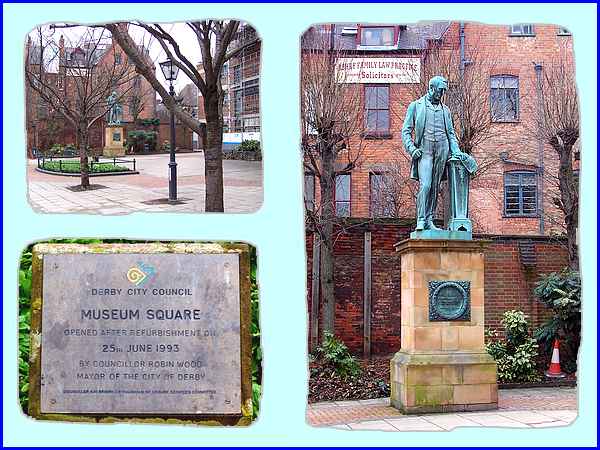
 The Jacobean House
was viewed from the opposite side of the road where an open area
adjacent to the library, museum and art gallery complex was opened
after refurbishment by the Mayor of Derby, Councillor Robin Wood
on June 25th 1993 as Museum Square. The Square's focal point
is a statue erected by public subscription of Michael Thomas Bass II (1799 - 1884), MP
for Derby from 1848 to 1883. Bass was a brewer and expanded the
family business established in Burton on Trent and in the process
became a generous benefactor to both Burton and Derby. The adjacent
museum complex was funded by Bass and is where we will start
Part 15 of our Heritage Walk. At the moment it is shrouded by
scaffolding (right) and is undergoing some major repair and restoration
work so I'm hoping that more will be visible next month. The Jacobean House
was viewed from the opposite side of the road where an open area
adjacent to the library, museum and art gallery complex was opened
after refurbishment by the Mayor of Derby, Councillor Robin Wood
on June 25th 1993 as Museum Square. The Square's focal point
is a statue erected by public subscription of Michael Thomas Bass II (1799 - 1884), MP
for Derby from 1848 to 1883. Bass was a brewer and expanded the
family business established in Burton on Trent and in the process
became a generous benefactor to both Burton and Derby. The adjacent
museum complex was funded by Bass and is where we will start
Part 15 of our Heritage Walk. At the moment it is shrouded by
scaffolding (right) and is undergoing some major repair and restoration
work so I'm hoping that more will be visible next month.
|

